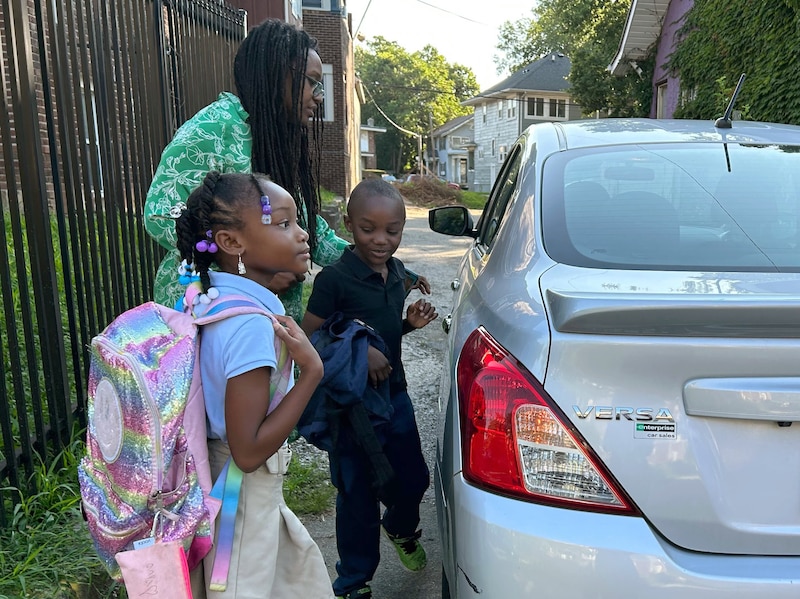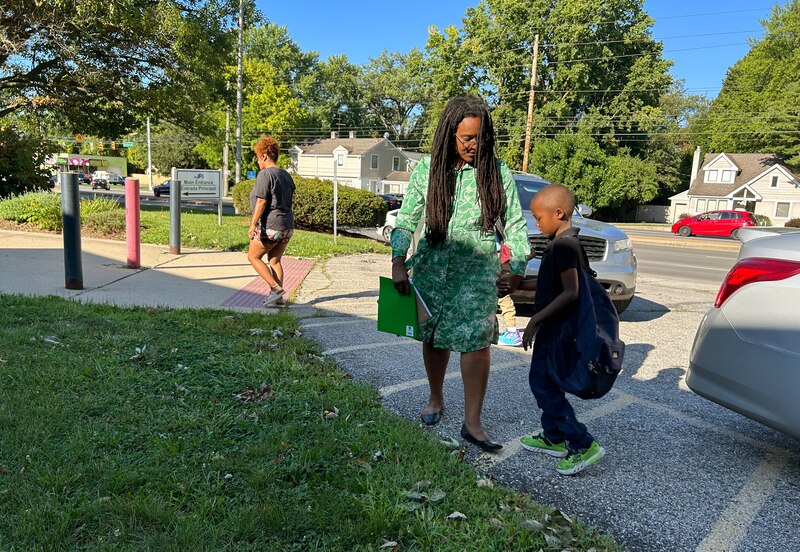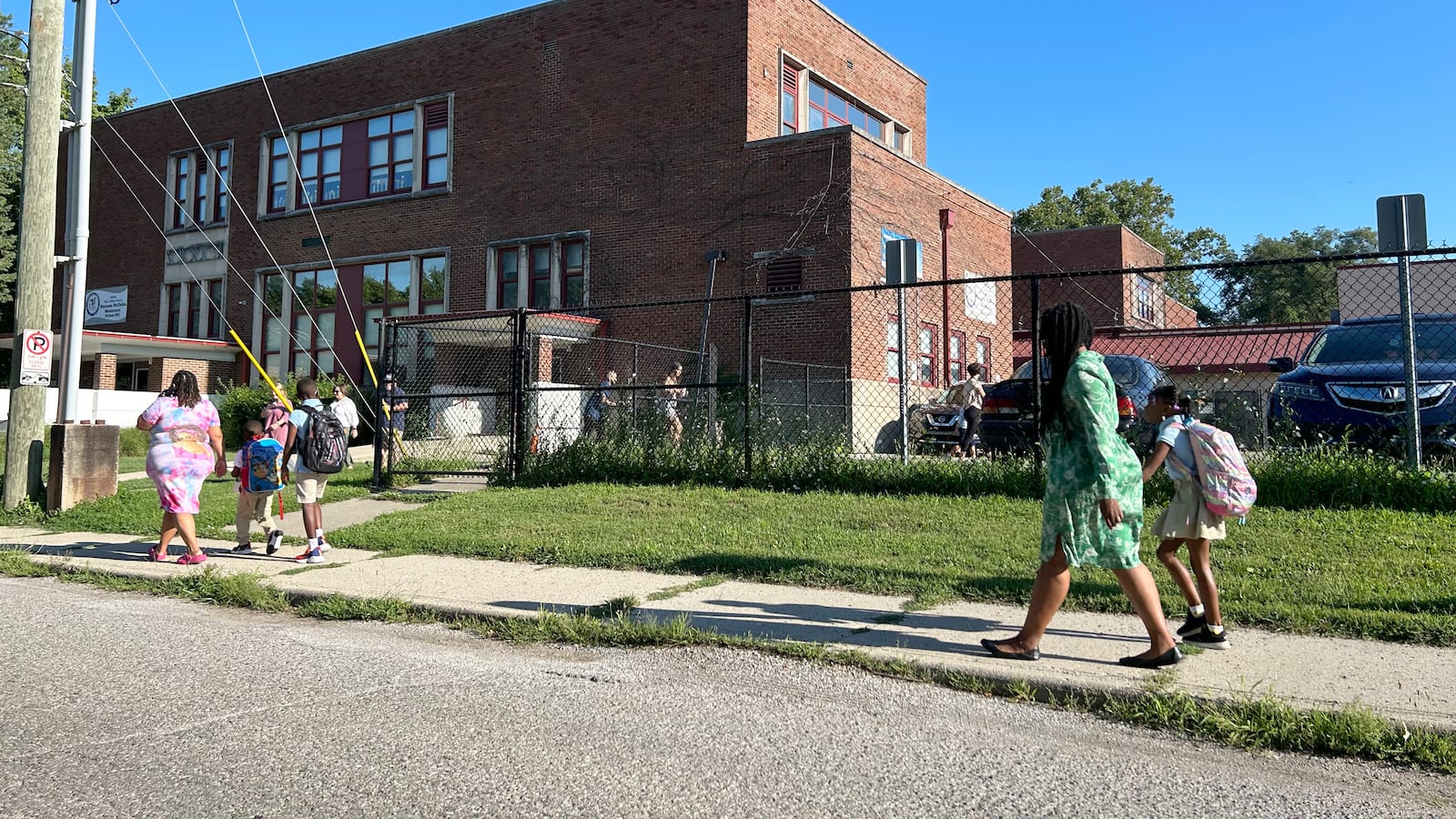Zola and Jehu Jorman climbed into the backseat of their mother DeShawn’s car on Monday morning, where bags of crayons and notebooks awaited them.
“Cool school supplies, mommy,” Zola, a third grader, said just before she tore into the packaging for a new pair of scissors.
The two siblings had been in school together at Francis Parker School 56, a Montessori school in the predominantly Black Hillside neighborhood of Indianapolis that shepherded their four older siblings through eighth grade. But with the closure of School 56 this year, the two are parting ways. Jehu, a second grader, was accepted into the Sidener Academy for High Ability Students. Zola is continuing her Montessori education at Rousseau McClellan School 91.
“I’m kind of nervous but I’m kind of excited,” Zola said. She was up at 7 a.m. — an hour before Jehu, she pointed out, even though she stayed up later last night while her older sister did her hair.

The start of school on Monday marks the beginning of a monumental shift for Indianapolis Public Schools and its students. The district, struggling with a consistent decline in enrollment, has launched its Rebuilding Stronger plan to run the downsized district more efficiently and compete with private and charter schools.
The first step in that plan started this year: closing down six schools, including School 56, and moving over 1,200 students and 300 staff elsewhere.
DeShawn Jorman is used to upheaval in IPS. Her eldest daughter was a senior at Shortridge High School in 2019 when Broad Ripple High School closed and merged with Shortridge.
This time, Jorman thought long and hard about what to do next with her two youngest children.
As students of the closing School 56, Zola and Jehu had a guaranteed spot at James Russell Lowell School 51, which will merge with School 56 and become a Montessori school. But Jorman chose to send them elsewhere.
“This was not an easy decision to make,” said Jorman, who fought for School 56 to stay open. “It wasn’t as easy as the decision that they [made] to shut that school down.”
IPS: Enrollment ‘steady’ on first day of school
Superintendent Aleesia Johnson said the district’s student enrollment remained similar to last year’s figure, which stood at 22,027, for the district’s non-charter schools, according to state records. When counting the district’s charter schools within its Innovation Network, that number stands at about 31,000, per the district.
Johnson said that’s a positive sign in light of Rebuilding Stronger.
“We’ve been watching those numbers to sort of see how we’re looking and overall, I would characterize it as steady,” Johnson said Monday morning.
The district reported 152 classroom teaching vacancies last week, a vacancy rate of 12%. IPS also still needed 204 support staff, a 22% vacancy rate.
But the majority of staff who were displaced due to school closures under Rebuilding Stronger stayed in the district.
This year, the district faces even greater competition for its students. The state’s expansion of its voucher program, which funds private school education with taxpayer dollars, means roughly 97% of all students will qualify for the subsidies.
But Johnson said she does not expect vouchers, which expanded this year to cover wealthier families, to have a tremendous impact on enrollment.
For parents like Jorman whose children are undergoing significant change, Johnson reiterated a philosophy she often touted during the past year: acknowledge the grief that comes with school closures, but also hold hope for the future. She wants families to feel supported and cared for at their new schools like they did at their prior ones.
“Ultimately, I believe the shifts we’re making are going to be for the betterment of our kids and our families in terms of the experiences that we’ll get to have and what we’ll be able to offer and commit to them,” she said.
The district’s Rebuilding Stronger plan replicates academic models that officials say are in high demand, and it seeks to close learning gaps across racial subgroups by bringing these programs to schools throughout the district. The reorganization expands International Baccalaureate, Montessori, dual language, high ability, arts, and STEM programming. It also reconfigures grades, breaking up the K-8 model at many schools and creating standalone elementary and middle schools.
Nearly all of those changes, however, won’t take place until 2024-25.
‘What can schools do to keep students?’
From the backseat, Jehu watched as his mother walked Zola to the entrance of School 91. While his older sister was bubbly about the prospect of a new school, he was less enthusiastic.
“Mom, why do me and Zola go to different schools?” he asked as Jorman pulled away from the drop-off area and headed to Sidener.

“Because your school closed down, baby,” she replied.
Jorman did not want to send her youngest children to School 51 during its shift to Montessori programming. She loves Montessori education — she just didn’t want her children to be in a new school community that might not love it back.
“I’m concerned about forcing a specialized program on a community school,” she said. “They did not ask for that.”
She and her family pushed for School 56 to remain open, launching an online petition to save the building from closure. Jorman and her daughter stressed its place as an anchor in the community.
But to them, all those points fell on deaf ears.
“[School] 56 was a family, and the school board doesn’t care about that,” Jorman said. “It wasn’t just a school.”
Jorman’s eldest daughter, Mesgana Waiss, reflected on her own experience as an IPS graduate as she and Jorman discussed the best options for her siblings.
Now, as a senior in college, looking back at all the school closures makes Waiss sad.
“It’s almost like every five to 10 years, the district gets smaller,” she said. “What can schools do to keep students? And then what can they do for students that are leaving?”
Despite the difficulties, Jorman still has hope for the new school year. She hopes Jehu will be challenged at his new school. She wants Zola to continue in her Montessori education, which she thinks is good for her.
Jehu was crying as Jorman dropped him off into his new classroom at Sidener, she said.
But Jehu found his table right next to another little girl, who recognized him.
“She said, ‘Is he from Francis W. Parker?’ And I said yes,” Jorman said. “She’s like, ‘Yes, I used to go there too.’”
Amelia Pak-Harvey covers Indianapolis and Marion County schools for Chalkbeat Indiana. Contact Amelia at apak-harvey@chalkbeat.org.
Clarification: This article has been updated to include IPS’s enrollment with students who attend charter schools in the district’s Innovation Network.


